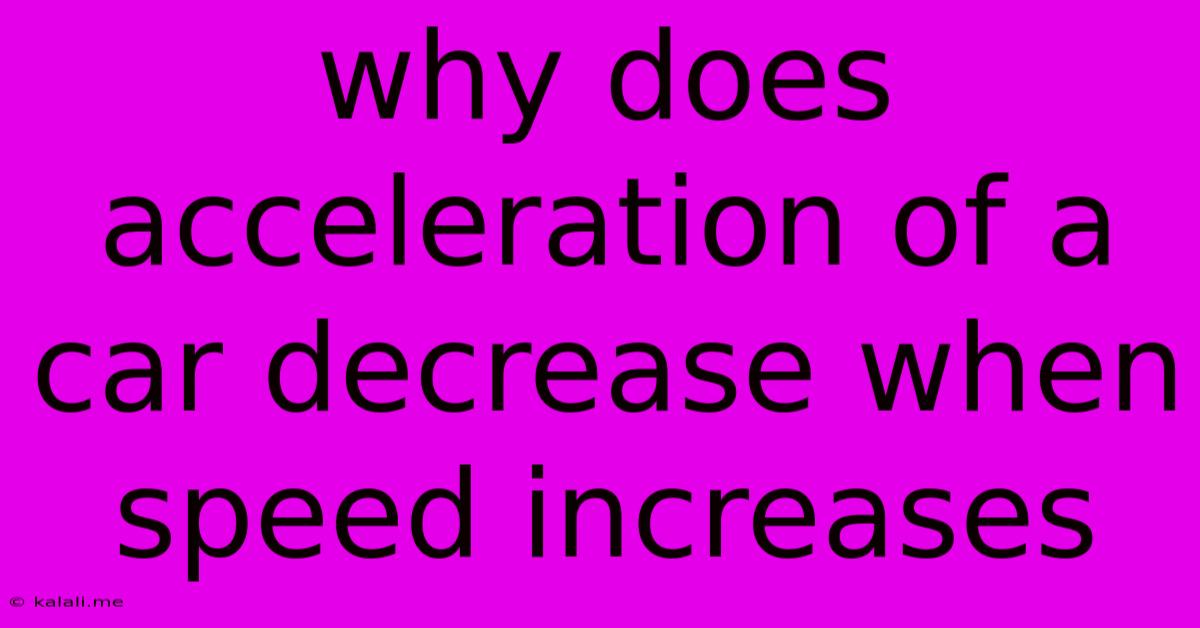Why Does Acceleration Of A Car Decrease When Speed Increases
Kalali
Jun 06, 2025 · 3 min read

Table of Contents
Why Does Car Acceleration Decrease as Speed Increases?
The exhilarating feeling of a car's rapid acceleration diminishes as speed climbs. This isn't a quirk of automotive engineering; it's a fundamental consequence of physics. This article will explore the primary reasons why a car's acceleration decreases as its speed increases, focusing on the interplay of power, drag, and inertia. Understanding these factors is crucial for both drivers and automotive enthusiasts.
The Role of Power and Torque
A car's engine produces power, measured in horsepower or kilowatts. This power is used to overcome various resistances, allowing the car to accelerate. Crucially, the rate of acceleration is directly linked to the engine's torque – the rotational force it generates. While horsepower represents the rate at which work is done, torque represents the force itself.
However, the relationship between engine power and speed is not linear. An engine's ability to deliver torque diminishes as RPM (revolutions per minute) increases beyond its peak torque range. To maintain acceleration at higher speeds, the engine needs to operate at higher RPMs, but this often means operating beyond its peak torque point, resulting in reduced acceleration. This is why you might experience a less pronounced "kick" when accelerating from 60mph compared to 20mph.
The Dominating Force: Air Resistance (Drag)
As a car's speed increases, the force of air resistance, also known as drag, dramatically increases. This force acts directly against the car's motion, significantly hindering acceleration. Drag is influenced by several factors, including:
- Vehicle shape: A more aerodynamic design reduces drag.
- Frontal area: Larger vehicles experience greater drag.
- Air density: Denser air (at higher altitudes or lower temperatures) creates more drag.
- Speed: Drag increases proportionally to the square of the speed. This means that doubling the speed quadruples the drag force.
This exponential relationship between speed and drag is the primary reason why acceleration tapers off dramatically at higher speeds. The engine must work much harder to overcome this significantly increased resistance, leading to a noticeable decrease in acceleration.
Inertia and the Increasing Mass
While less significant than drag, inertia also plays a role. Inertia is the resistance of an object to changes in its velocity. As the car's speed increases, its momentum (mass x velocity) also increases. Therefore, it requires more force to further increase its speed, contributing to the reduced acceleration. This effect is less pronounced than drag at typical road speeds, but it becomes increasingly relevant at very high speeds.
Gear Ratios and Transmission Efficiency
Gear ratios in a car's transmission are designed to optimize the engine's torque output at different speeds. Lower gears provide higher torque for initial acceleration, while higher gears are geared for higher speeds but with less torque. As you shift to higher gears at higher speeds, the engine operates at lower RPM, providing less torque and therefore a noticeable reduction in acceleration. Transmission efficiency also contributes to this. Energy losses within the transmission are unavoidable and increase with speed.
Conclusion: A Complex Interplay
The decrease in a car's acceleration as speed increases is a result of the combined effects of diminishing engine torque at higher RPMs, the exponentially increasing force of air resistance, and the increasing inertia of the vehicle. Understanding these factors helps explain why acceleration is so much more pronounced at lower speeds and why reaching higher top speeds requires progressively more powerful engines and sophisticated aerodynamic design. This knowledge is not just interesting, it is crucial for engineers designing high-performance vehicles and for drivers understanding the limits of their car's performance.
Latest Posts
Latest Posts
-
How To Reset View In Blender
Jun 07, 2025
-
How Do You Remove Adhesive From Tiles
Jun 07, 2025
-
What Does It Mean To Hear Some T
Jun 07, 2025
-
Does He Have The Same Line Emission Spectrum As H
Jun 07, 2025
-
How To Tile A Shower Niche
Jun 07, 2025
Related Post
Thank you for visiting our website which covers about Why Does Acceleration Of A Car Decrease When Speed Increases . We hope the information provided has been useful to you. Feel free to contact us if you have any questions or need further assistance. See you next time and don't miss to bookmark.